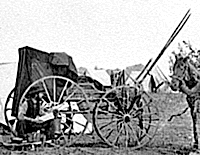Many of them spend copious amounts of time involving themselves in reenactments of battles and life as it was during that time.
Civil War Reenactment HQ offers a collection of information about this including a lists of events, units, and a beginners guide to reenactments.
The Civil War Reenactors Homepage has a lot of information as well. But what I really wanted to write about here are those old time photographs that we see from that time period. Photography was much more time consuming and difficult than it is today.
"During the Civil War, the process of taking photographs was complex andAside from the difficulty in taking photos I always find it interesting to see how serious so many of the subjects of the photos were. Few if any appear to be smiling.Thanks to the Library of Congress I have a few samples to share here. This link takes you here:time-consuming. Two photographers would arrive at a location. One would mix chemicals and pour them on a clean glass plate. After the chemicals were given time to evaporate, the glass plate would be sensitized by being immersed -- in darkness -- in a bath solution. Placed in a holder, the plate would then be inserted in the camera, which had been positioned and focused by the other photographer. Exposure of the plate and development of the photograph had to be completed within minutes; then the exposed plate was rushed to the darkroom wagon for developing. Each fragile glass plate had to be treated with great care after development -- a difficult task on a battlefield."
Pictured above Cold Harbor, Va. Photographer's wagon and tent Between 1860 and 1865
The Selected Civil War Photographs Collection contains 1,118 photographs. Most of the images were made under the supervision of Mathew B. Brady, and include scenes of military personnel, preparations for battle, and battle after-effects. The collection also includes portraits of both Confederate and Union officers, and a selection of enlisted men. An additional two hundred autographed portraits of army and navy officers, politicians, and cultural figures can be seen in the Civil War photograph album, ca. 1861-65. (James Wadsworth Family Papers). The full album pages are displayed as well as the front and verso of each carte de visite, revealing studio logos, addresses, and other imprint information on the approximately twenty photographers represented in the album.
 [Washington, D.C. President Lincoln's funeral procession on Pennsylvania Avenue].
[Washington, D.C. President Lincoln's funeral procession on Pennsylvania Avenue].
[Atlanta, Ga. Gen. William T. Sherman, leaning on breach of gun, and staff at Federal Fort No. 7].
[Fort Monroe, Va. Officers and ladies on porch of a garrison house].
One of these days I am going to have to learn how to code more effectively so that I can lay these out in nicer and more orderly fashion.



7 comments:
I had a neat experience with some Civil war reenactors at the school I taught at some years ago. They are a neat group of people for the most part and have a lot to share. I think its cool that they do what they do- so much better than reading about it in a textbook.
Sometimes seeing things brought to life is so much more powerful.
I too have an interest in the Civil War. I highly recommend Shelby Foote's three volume series on the subject.
M,
I'll have to take a look at that.
I'm not 100% certain, but I believe that some of the "stiffness" of the photographic subjects (the people) is because they needed a much longer exposure time than we do now. I'm not sure when it changed, but there was a while where it was hard to hold off blinking enough for the photo to complete. (here is one description of getting your picture taken in those days).
G,
Thanks, I have to check out the link.
Ooh, I loved this post. I have a long-time fascination with photographs from the Civil War- even the ones of dead soldiers lying on the battlefields (morbid, I know).
I read somewhere that one reason nobody smiled in pics from that era is because everyone had such bad teeth!
Post a Comment